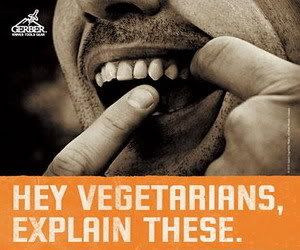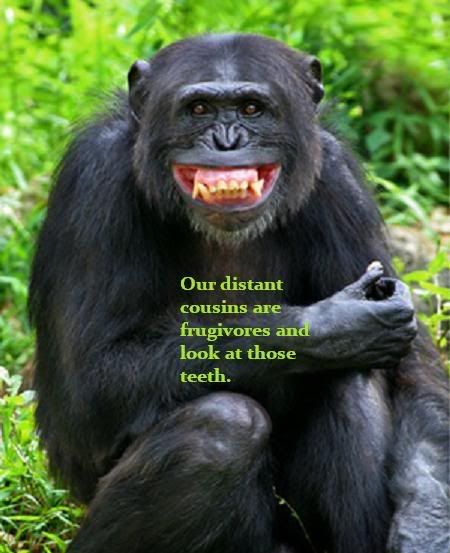Martha

Abolish legalized animal cruelty - Abolish Hunting
hahhahaaaaaaaaaaa hunters = stoooopid lol
Nephesh ~ Abolition, Direct Action and Veganism
I found the "canine" photo at a hunters myspace

BUT WE ARE FRUGIVORES

Are We Natural Meat-Eaters or Are We Natural Vegetarians?
Sink Your Teeth into This!
Most "nutritionists" assert that we have definite carnivorous leanings, and some have even termed our incisor teeth "fangs" in defense of their erroneous position that humans are natural meat-eaters! If you look at the various species in the animal kingdom, each is equipped with teeth that are ideally suited to masticate a particular type of food. Herbivores (like the cow) have 24 molars, eight jagged incisors in the lower jaw and a horny palate in the upper jaw. Their jaws move vertically, laterally, forward, and backward, enabling the herbivore to tear and grind coarse grasses. Omnivores (like the hog) may have tusk-like canines allowing them to dig up roots. Frugivores (like the chimpanzee) have 32 teeth: sixteen in each jaw including four incisors, two cuspids, four bicuspids, and six molars. The cuspids are adapted for cracking nuts, and the uniform articulation of the teeth enables the frugivore to mash and grind fruits. On the contrary, carnivores (like the cat family) have markedly developed canines that are long, sharp, cylindrical, pointed, and set apart from the other teeth. Fangs and sharp pointed teeth that penetrate and kill, that rip and tear flesh, are a feature of all true carnivores (except certain birds). The powerful jaws of the carnivore move only vertically, and are ideal for ripping and tearing flesh that is swallowed virtually whole and then acted upon by extremely potent gastric juices. Human teeth are not designed for tearing flesh as in the lion, wolf or dog, but rather compare closely with other fruit-eating animals. Human teeth correspond almost identically to the chimpanzees and other frugivores. The complete absence of spaces between human teeth characterizes us as the archetype frugivore. The "canine" teeth of humans are short, stout, and slightly triangular. They are less pronounced and developed than the orangutans, who rarely kills and eats raw flesh in its natural environment. Human canines in no way resemble the long, round, slender canines of the true carnivore. Human teeth are not curved or sharp like the wolves or tigers, nor are they wide and flat like the grass and grain-eating species. Human teeth are actually like the fruit-eating monkeys, and the human mouth is best suited for eating succulent fruits and vegetables. It would be extremely difficult, if not impossible, for humans to eat raw flesh without the aid of fork and knife. To term our incisor teeth "fangs" or even to liken them as such is outrageous.
'Linneaus, who introduced binomial nomenclature (naming plants
and animals according to their physical structure) wrote:
"Man's structure, external and internal, compared with that of other animals
shows that fruit and succulent vegetables constitute his natural food.
"
(source)














0 Comments:
Post a Comment